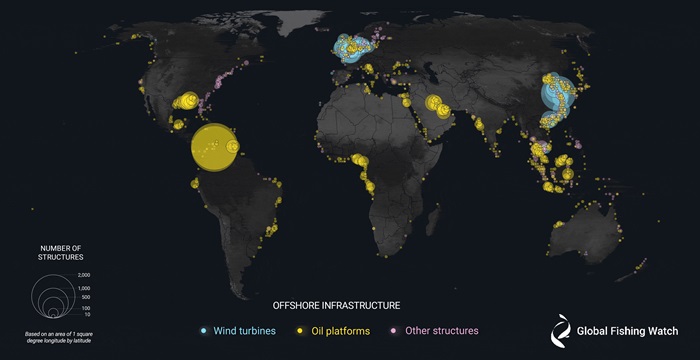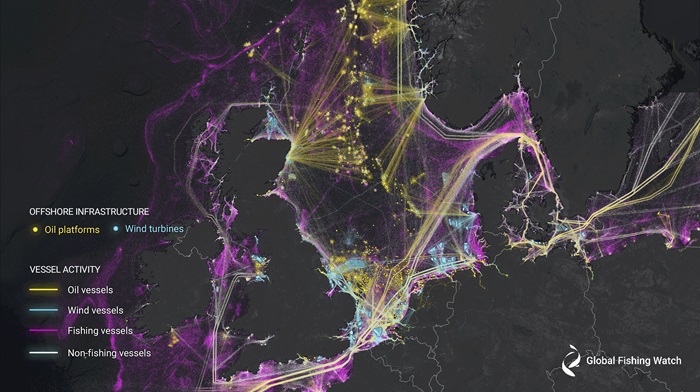Study reveals 75 percent of the world’s industrial fishing vessels are hidden from public view
WASHINGTON, D.C., Jan. 03, 2024 (Korea Bizwire) – A new study published today in the journal Nature offers an unprecedented view of previously unmapped industrial use of the ocean and how it is changing.
The groundbreaking study, led by Global Fishing Watch, uses machine learning and satellite imagery to create the first global map of large vessel traffic and offshore infrastructure, finding a remarkable amount of activity that was previously “dark” to public monitoring systems.
The analysis reveals that about 75 percent of the world’s industrial fishing vessels are not publicly tracked, with much of that fishing taking place around Africa and south Asia. More than 25 percent of transport and energy vessel activity are also missing from public tracking systems.
“A new industrial revolution has been emerging in our seas undetected—until now,” said David Kroodsma, director of research and innovation at Global Fishing Watch and co-lead author of the study. “On land, we have detailed maps of almost every road and building on the planet. In contrast, growth in our ocean has been largely hidden from public view. This study helps eliminate the blind spots and shed light on the breadth and intensity of human activity at sea.”
Researchers from Global Fishing Watch, the University of Wisconsin-Madison, Duke University, UC Santa Barbara and SkyTruth analyzed 2 million gigabytes of satellite imagery spanning 2017-2021 to detect vessels and offshore infrastructure in coastal waters across six continents where more than three-quarters of industrial activity is concentrated.
By synthesizing GPS data with five years of radar and optical imagery, the researchers were able to identify vessels that failed to broadcast their positions. Using machine learning, they then concluded which of those vessels were likely engaged in fishing activity.
“Historically, vessel activity has been poorly documented, limiting our understanding of how the world’s largest public resource—the ocean—is being used,” said co-lead author Fernando Paolo, senior machine learning engineer at Global Fishing Watch. “By combining space technology with state-of-the-art machine learning, we mapped undisclosed industrial activity at sea on a scale never done before.”
While not all boats are legally required to broadcast their position, vessels absent from public monitoring systems, often termed “dark fleets,” pose major challenges for protecting and managing natural resources. Researchers found numerous dark fishing vessels inside many marine protected areas, and a high concentration of vessels in many countries’ waters that previously showed little-to-no vessel activity by public monitoring systems.
“Publicly available data wrongly suggests that Asia and Europe have similar amounts of fishing within their borders, but our mapping reveals that Asia dominates—for every 10 fishing vessels we found on the water, seven were in Asia while only one was in Europe,” said co-author Jennifer Raynor, assistant professor of natural resource economics at the University of Wisconsin-Madison. “By revealing dark vessels, we have created the most comprehensive public picture of global industrial fishing available.”
The study also shows how human activity in the ocean is changing. Coinciding with the COVID-19 pandemic, fishing activity dropped globally by about 12 percent, with an 8 percent decline in China and a 14 percent drop elsewhere. In contrast, transport and energy vessel activity remained stable.
Offshore energy development surged during the study period. Oil structures increased by 16 percent, while wind turbines more than doubled. By 2021, turbines outnumbered oil platforms. China’s offshore wind energy had the most striking growth, increasing ninefold from 2017 to 2021.
“The footprint of the Anthropocene is no longer limited to terra firma,” said co-author Patrick Halpin, professor of marine geospatial ecology at Duke University. “Having a more complete view of ocean industrialization allows us to see new growth in offshore wind, aquaculture and mining that is rapidly being added to established industrial fishing, shipping and oil and gas activities. Our work reveals that the global ocean is a busy, crowded and complex industrial workspace of the growing blue economy.”
The study highlights the potential of this new technology to tackle climate change. Mapping all vessel traffic will improve estimates of greenhouse gas emissions at sea, while maps of infrastructure can inform wind development or aid in tracking marine degradation caused by oil exploration.
“Identifying offshore infrastructure is critical for understanding offshore energy development impacts and trends, and is crucial data for our work to detect marine pollution events and hold responsible parties to account,” said co-author Christian Thomas, a geospatial engineer at SkyTruth.
The open data and technology used in the study can help governments, researchers and civil society to identify hotspots of potentially illegal activity, determine where industrial fishing vessels may be encroaching on artisanal fishing grounds, or simply better understand vessel traffic in their waters.
“Previously, this type of satellite monitoring was only available to those who could pay for it. Now it is freely available to all nations,” concluded Kroodsma. “This study marks the beginning of a new era in ocean management and transparency.”
The study was made possible thanks to the generous support of Bloomberg Philanthropies, National Geographic Pristine Seas and Oceankind, and our technology partner, Google. As an awardee of The Audacious Project, a collaborative funding initiative that is catalyzing social impact on a grand scale, Global Fishing Watch is able to further the application of this innovative work.
Notes to the editor:
- Download supporting data visualizations and figures from the paper here: Media kit
- Download the data at: https://globalfishingwatch.org/datasets-and-code
- Data providers: The co-authors of the study wish to acknowledge the contribution from the following technology and data providers; AIS: Spire, ORBCOMM; Radar and optical imagery: European Space Agency (ESA); and Computing resources: Google / Earth Engine.
Global Fishing Watch is an international nonprofit organization dedicated to advancing ocean governance through increased transparency of human activity at sea. By creating and publicly sharing map visualizations, data and analysis tools, we aim to enable scientific research and transform the way our ocean is managed. We believe human activity at sea should be public knowledge in order to safeguard the global ocean for the common good of all.
Attachments

Sarah Bladen
Global Fishing Watch
+44 79 20333832
sarah.bladen@globalfishingwatch.org
Lisa Tossey
Global Fishing Watch
+1 302 4486638
lisa.tossey@globalfishingwatch.org
Source: Global Fishing Watch via GLOBE NEWSWIRE









